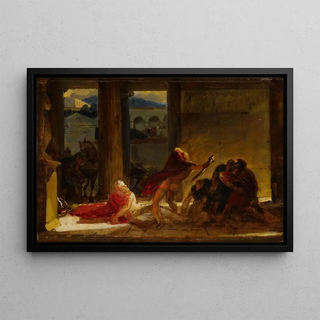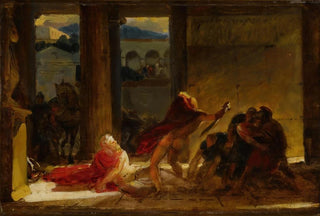Art print | The Death of Pyrrhus - Anne-Louis Girodet-Trioson


View from behind

Frame (optional)
The Death of Pyrrhus: A Timeless Tragic Drama
In this striking artwork, "The Death of Pyrrhus," the painter captures the fateful moment when the king of Epirus meets his destiny. The dark colors and striking contrasts evoke an atmosphere of despair and tragedy. The figures, rendered with remarkable precision, seem to vibrate with emotion, while the dynamic composition guides the viewer's gaze across the scene. The artist's technique, skillfully blending chiaroscuro, enhances the dramatic intensity of this canvas, making each detail an essential narrative element. This painting, a true invitation to contemplation, immerses us in a mythological story where fate asserts itself powerfully.
The Death of Pyrrhus: An Artistic Heritage Rich in History
"The Death of Pyrrhus" is the work of an artist whose name resonates with the grandeur of Neoclassicism. This movement, which flourished at the end of the 18th century, is characterized by a return to the values of Antiquity, both in themes and techniques. The artist, influenced by Renaissance masters and mythological stories, was able to infuse his works with emotional depth and formal rigor. Drawing inspiration from tales of heroism and tragedy, he helped shape an aesthetic that continues to influence contemporary artists. "The Death of Pyrrhus" thus fits into a tradition that celebrates the beauty and pain of human existence.
A decorative acquisition with multiple assets
Choosing an art print of "The Death of Pyrrhus" for your interior is opting for a centerpiece that inspires admiration. Whether in a living room, office, or bedroom, this piece will add a touch of elegance and depth to your decor. Its reproduction quality guarantees fidelity to the original details, allowing you to feel the full emotional power of the work. With its undeniable aesthetic appeal, this canvas becomes not only a decorative element but also a captivating conversation piece, enriching your living space with a timeless story.

Matte finish

View from behind

Frame (optional)
The Death of Pyrrhus: A Timeless Tragic Drama
In this striking artwork, "The Death of Pyrrhus," the painter captures the fateful moment when the king of Epirus meets his destiny. The dark colors and striking contrasts evoke an atmosphere of despair and tragedy. The figures, rendered with remarkable precision, seem to vibrate with emotion, while the dynamic composition guides the viewer's gaze across the scene. The artist's technique, skillfully blending chiaroscuro, enhances the dramatic intensity of this canvas, making each detail an essential narrative element. This painting, a true invitation to contemplation, immerses us in a mythological story where fate asserts itself powerfully.
The Death of Pyrrhus: An Artistic Heritage Rich in History
"The Death of Pyrrhus" is the work of an artist whose name resonates with the grandeur of Neoclassicism. This movement, which flourished at the end of the 18th century, is characterized by a return to the values of Antiquity, both in themes and techniques. The artist, influenced by Renaissance masters and mythological stories, was able to infuse his works with emotional depth and formal rigor. Drawing inspiration from tales of heroism and tragedy, he helped shape an aesthetic that continues to influence contemporary artists. "The Death of Pyrrhus" thus fits into a tradition that celebrates the beauty and pain of human existence.
A decorative acquisition with multiple assets
Choosing an art print of "The Death of Pyrrhus" for your interior is opting for a centerpiece that inspires admiration. Whether in a living room, office, or bedroom, this piece will add a touch of elegance and depth to your decor. Its reproduction quality guarantees fidelity to the original details, allowing you to feel the full emotional power of the work. With its undeniable aesthetic appeal, this canvas becomes not only a decorative element but also a captivating conversation piece, enriching your living space with a timeless story.






